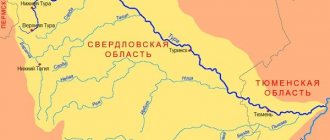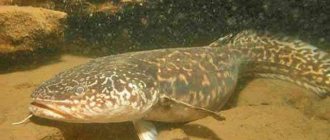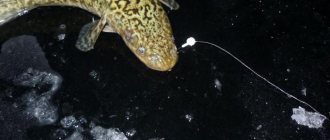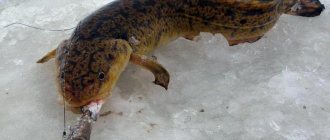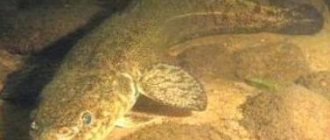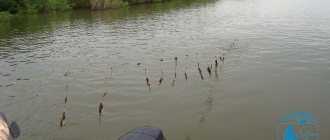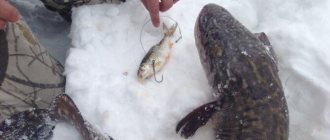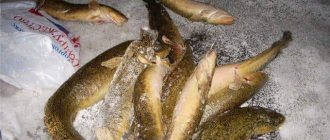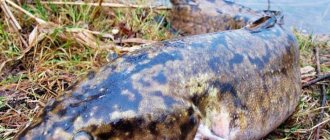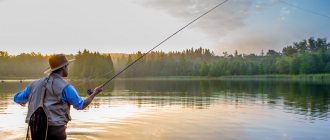What it is?
This tackle is a type of hook fishing net. It consists of a thick main rope on which long leashes with hooks are fixed. It is not difficult to install such tackle. The twine can be tied on both sides to guards (long rods, usually made of spring metal or polymer), which are also called bite alarms for bottom gear. Also, the main rope can be fixed to two snags protruding above the surface of the reservoir, to stakes driven into the bottom and other supports. The most important thing is that before installing the network, you need to determine which direction the water flows. This is necessary because the tackle is placed not along the current, but across it.
This net is used to catch not only burbot, but also other large predators, for example, pike, catfish, and pike perch. The harness can be used both in summer and winter, fixing the main rope on the ice.
Rice. 1. An example of installing a saddle.
If you don’t know how to set the line correctly, problems with fisheries inspection may arise. This gear will be considered poaching. Primary requirements:
Usually these rules are violated by fishermen who make their own nets. Manufacturers of this gear know the law, so in fishing stores you can only find those nets that meet all the requirements.
Transfer to burbot
Bottom tackle is somewhat different from bottom tackle in that it has a large number of hooks. The presence of so many hooks makes this tackle less attractive, although many fishermen use it to catch not only burbot, but also other fish. Setting up the net takes a lot of time, but the presence of a large number of hooks makes it very catchy. The problem with installing a line is that you have to fish with it at night, when visibility is limited.
To make it you will need:
- Main line or cord. Many fishermen use cord to make a saddle. It is more reliable, especially in the current.
- Sinker 100-250g.
- Line for leashes with a diameter of 0.2-0.4 mm.
There can be a lot of debate about the technique of fishing with a line, but it requires a special approach, since a large number of hooks on the tackle creates certain problems. When fishing for burbot, you can use both live bait and other baits of animal origin as bait.
Installation Rules
Before you go to set the line, you need to familiarize yourself with the weather forecast in advance. Burbot bites better when:
How to quickly install tackle when there is a boat:
Rice. 3. The tackle can be installed at dusk and returned for it in the morning. Even if the burbot stays on the hook for several hours, nothing will happen to it during this time.
Method of installing the saddle in winter:
Rice. 4. Unlike many other fish, burbot is active in winter, so even trophy specimens can be caught on the line.
Differences from catfish
Burbot is very similar to catfish, and beginners in fishing or people far from this process can easily confuse these two freshwater predators. The main external differences are:
- The presence of one whisker on the chin, which is characteristic of all cod representatives.
- The whiskers on the upper jaw of the burbot are much smaller than the characteristic large ones of the catfish.
- Catfish grow to very impressive sizes.
- The head of the catfish is large, in contrast to the flattened burbot.
- The catfish has a darker color without pronounced chaotic spots throughout the body.
In addition to external ones, there are other significant differences between these two predators. So the first one shows its maximum activity in the cold season, which cannot be said about the catfish, whose feeding occurs in the period May-July. Burbot spawns in winter, and catfish - at the end of May.
The fish reaches sexual maturity at 3–4 years of age. From this period, he begins to take an active part in procreation. His zhor begins at the end of autumn and lasts almost three months. Moreover, in December-January the predator makes spawning migrations. In rivers it moves upstream to shallow areas. The burbot in the lake is also moving from the depths closer to the shore. Here he selects areas with a sandy and rocky bottom, where he then spawns. The spawning process itself begins at the end of January at a water temperature of about 1–2 degrees. Large individuals begin spawning first, then young fish follow.
Burbot is a prolific predator. During spawning, the female of this predator can lay up to a million eggs. The burbot caviar itself has a yellowish tint and does not exceed 1 mm in diameter. This fertility of fish is associated with the spawning period, when other fish do not migrate through the reservoir and feed. Especially burbot eggs are eaten by the ubiquitous perch, cheeky ruff and gudgeon. A large number of eggs helps in the survival of the population of this cod species.
How to catch burbot using a line?
Showing the wonders of fish laziness in the summer, in winter the burbot radically changes its lifestyle and actively hunts, eating the “fat.” Fish lose weight intensively only during the spawning period, which also occurs in winter (mid-January - February).
During these two weeks, the burbot loses most of its excess weight, as, obeying its reproductive instincts, it misses hunting hours.
After spawning, the fish quickly restores its lost forms and leads an active nocturnal lifestyle until spring warming. In summer, burbot literally “lies on the bottom” and rarely shows its nose from the shelter, as it cannot stand the heat.
An increase in water temperature of more than 25 degrees can be fatal for burbot, so they are found in those reservoirs where a cooler place can be found. For example, near a hard bottom, where an icy stream flows into a river or lake.
Burbot is highly valued by gourmets. In cooking, the liver of this representative of cod is most often used, from which a wonderful pate is obtained.
Burbot fillet becomes the basis for aromatic fish soup, French matlot, roast, cutlets and several dozen other exotic and simple dishes.
Some may find the fish too oily. Although it can be stored frozen, it is recommended to consume burbot immediately, since after freezing its meat loses the subtle notes of special taste that are present in fresh fillets.
Now let’s learn about the intricacies of winter fishing for burbot.
What is a shift?
A sieve is one of the types of hook nets. Fishing tackle consists of a series of belts with hooks attached to string (sometimes to fishing line). On both sides it connects with gatehouses.
The classic guard is also made of twine, to which a bite alarm and a weight are attached.
They go with gear for predators: burbot, catfish, pike perch, pike. The structure of the saddle is quite primitive, so such tackle is easy to build at home.
Amateur crossings and crossings breaking the law
The attitude of fish inspectors, as well as the fishing community, towards the net is twofold, since if used incorrectly, the net spoils a lot of fish, but not all nets violate the law.
You only need to follow two rules:
- Firstly, you cannot set lines without bait. Self-catching hooks are usually used. This is deliberate, targeted poaching. Secondly, you cannot use nets with more than 10 hooks.
Manufacturers of fishing tackle know this, which is why you won’t find tackle with a large number of hooks in any fishing store.
In homemade nets, fishermen may neglect this requirement, but then one should not be surprised at the fines for their use.
Before going fishing, every respectable person should familiarize himself with the list of places where it is allowed.
Different regions impose fishing bans during certain periods. The fisherman also needs to take this information into account.
When making a hook net for passive fishing you will need:
- A fishing line with a thickness of at least 0.5 mm. It can be replaced with rope. Sinker weighing 100-200 g. Leads with a diameter of up to 0.4 mm. Swivels and hooks according to the number of leashes (up to 10 pcs).
How to make a saddle with your own hands
The saddle is often not bought, but made at home. To do this, you don’t need to have any skills, just learn how to create a seam and repeat the process.
Materials
Before making this tackle, you need to select materials. Main line. Must be thick to withstand the stress of several large fish on the hooks. You can use monofilament thread with a thickness of 0.4-0.7 millimeters.
The thickness is selected depending on its quality and the size of the fish that lives in the reservoir.
The length depends on how many hooks will be located on the tackle, so there are no exact numbers. The only limitation is that the fishing line must be at least longer than 5 meters, because otherwise it will not work as it should.
On ice
Heavy weight sinker. Use what you have on hand. The weight of the load must be at least 100 grams, and preferably 150-250.
Line for leashes. More often, the same monofilament thread is chosen, but with a cross-section of 0.3-0.4 millimeters. The main thing is that they are thinner than the main line. Hooks will be attached to the leashes. It is more effective to fish with size 6-8 hooks. It is advisable to use options with an extended shank, since burbot swallows the bait very deeply, and it is difficult to get the hook.
No more than 10 hooks are attached to the tackle itself, otherwise it will be considered poaching. But at the same time, you need to buy hooks in reserve, since sometimes it is easier to tear off the leash and attach a new one than to try to get the bait out of your mouth on the spot.
The leashes themselves are attached to the fishing line using swivels. The number of swivels is the same as the number of hooks attached. It is also better to take them with a reserve, although the chances of losing them are quite small.
Examples of hooks with an extended shank
Manufacturing process
- First, a sinker is attached to one end of the main line. At a distance of 30-40 centimeters from it, a loop is made to which the swivel is attached.
- A leash with a hook is attached to the swivel. The same steps are repeated until the leashes are secured along the entire length of the fishing line.
- When assembling the gear, you need to remember that the smaller the distance between the leads, the greater the chance of tangling it, but at the same time a larger area of the reservoir will be fished.
- In this case, the number of hooks should not be more than 10. All that remains is to tie a guard with a signaling device to the other end, and the tackle is ready.
- The finished saddle can be wound on a homemade or purchased reel.
Fishing with a line in winter
How to set the line correctly?
There are three ways to install a net, but only bottom fishing is suitable for winter fishing.
The fisherman himself chooses the optimal place where the hunting routes of burbot pass, which, as is known, does not change its habits.
For ice fishing, holes are drilled at a distance of 5-8 m from each other.
The distance is chosen based on the length of the run (a stick that is launched under the ice) or a special wire hook.
The fisherman attaches the line itself directly to it, sequentially putting bait on the hooks as it is immersed in the water, and the run seems to “stretch” under the ice from hole to hole.
It is recommended to go fishing in winter with a group. While one fisherman lowers the line under the ice, the second puts on live bait. Then the tackle will not get tangled.
After the line is installed, it is slightly pulled up to evenly place the gear on the bottom.
The optimal time for installing a hook net for burbot is considered to be the period from 21:00 to 2:00-3:00. The catch should be checked early in the morning.
installation of a crossing on the current
Catching burbot using a line
For burbot, you can use nylon leashes. The fish has small bristly teeth that cannot damage the gear part.
Having taken the bait, she remains in place until she pulls it, along with the hook, deep into her stomach. So, for pike it is better to prepare stronger belts made of Kevlar or metal.
The fish may also not bite on live bait caught in another body of water.
Be prepared for the fact that the burbot will proudly refuse typical “autumn” treats like worms or small amphibians. You can also use frozen fish, but small and whole.
Pieces of meat or fish fillet attract only hungry gourmet burbots, while the rest simply swim by.
Source
Catching burbot - Video
Burbot
- the only representative of cod among freshwater fish. Burbot lives in rivers and lakes almost throughout Russia, except for the Caucasus and Kamchatka.
The appearance and way of life of burbot indicate that it is a relict fish, preserved since the Ice Age. It inherited the cold-loving nature of its ancestors and lives mainly in water bodies of the northern hemisphere. Especially common in the rivers of Siberia. A valuable commercial fish, burbot liver is of particular importance as a delicacy product rich in fat and vitamin A. Currently, throughout Russia there is a decrease in the number of burbot, a decrease in its average size due to overfishing and pollution of water bodies.
What is burbot bait and how to use it?
Burbot is a desirable but finicky prey. In many reservoirs the number of cod fish is insignificant, so sitting around waiting for a bite can be too tiring and uninteresting. There is a way to improve the likelihood of catching fish by using passive gear - a reel. Burbot using a net is no worse than using active types of gear, but the fisherman only needs to install it and remove it in the morning. An additional advantage of the gear is the ability to be in a warm house or car, and not freeze in a rainy autumn or frosty winter.
What is a seine for catching burbot?
Peremet is a passive tackle for burbot and a number of other predatory fish species. The gear is based on a stick, main cord, leashes and hooks. The installation of a burbot net is especially popular in northern latitudes, where it is called a longitudinal net. As a rule, the tackle is applicable if the angler wants to remove a predator from a reservoir, but it is often possible to catch peaceful or omnivorous fish. Predators are usually baited with live bait and pieces of dead fish, while peaceful ones are usually baited with corn kernels and shell meat.
Tackle for catching burbot in autumn
To catch burbot, fishermen use two types of gear: a long fishing rod or a net. Most likely, they are used based on the activity of a given fish when it rises from the depths closer to the surface. When it spends a lot of time closer to the bottom, you can use a “donka”, and when it is closer to the upper layers, you can use a line. Some “experts” believe that the “donka” and the seine are similar, but this is not so, they are completely different gear, designed for certain fishing conditions. A bottom fishing rod can have 1-2 hooks, no more, and a line can have 10-20 or more hooks, depending on the length. The barrier, as a rule, is installed on guy wires and blocks the river bed along its entire width. In still water, on a pond or lake, its length may vary.
Features of manufacturing and installation of the saddle
The first step in installing the tackle is to determine the length of the line; it directly depends on the desired number of hooks. The minimum length of fishing line immersed in water should be 5 m.
Before starting the production of the saddle, you need to prepare the materials needed during the work process.
It’s not difficult to make a do-it-yourself catch for burbot, but you will need to have the basic elements of gear:
You can make a burbot catch with your own hands in a traditional design and using various other techniques. To get acquainted with the tackle, the classic version is best.
How to make a catch for burbot:
What is the tackle?
Fishermen have been using lines for a long time. This catchy invention relates to a type of hook net. It is especially helpful during periods of weak bite when weather conditions change.
When the fish does not take a float rod or a spinning rod, a seine will surely help out.
When fishing from a boat or ice, the tackle looks like a rope with two weights on both sides.
For coastal fishing, use a stick, well fixed in the ground, with a reel or a feeder rod within 6 m in length.
In both cases, between the loads there is a main stretched fishing line or rope with a diameter of 0.5-0.8 mm, to which leashes 30-40 cm long and 0.3-0.4 mm thick are attached.
They can be knitted directly, using a loop and figure eight knot, or using carabiners, clasps and swivels. Hooks are already tied to the leashes.
It is important not to confuse the seine with the donka. The design of the gear is similar, but the bottom has only 1-2 hooks, and the net always has from 5 to 10 pieces, depending on the laws of the local fisheries inspection.
When and where to use
You can fish in 3 or more different places at once. It all depends on the fishing conditions (coastline topography, ice, weather).
With a reel on a boat, this method is used if it is difficult to get to the burbot’s habitat or to secure the tackle on both sides through a small channel. As a rule, this occurs at the end of spring, beginning of autumn, summer. At this time of year, burbot stands in the shade, under stones. It is almost inactive, and it is more difficult to get to it from the shore.
Recommended reading: How to catch pike perch with live bait
Shore fishing is most often used after the ice has melted in spring or autumn with the onset of cold weather, before freeze-up.
Winter is an active period for the exploitation of burbots, since burbot spends most of the day searching for food, namely in December and January. The duration may vary depending on the region and river.
How to make a catch for burbot
It is not difficult to assemble a net for catching burbot. The main thing is to know what the tackle looks like and what materials are useful for assembly.
Basic elements that will be needed for manufacturing:
- rope 0.8 mm thick;
- a load weighing at least 100 g;
- fishing line for leashes 0.5 mm thick;
- fasteners for a replaceable leash;
- hooks with a long shank.
The assembly order is as follows:
- A rope with a length of 50-70 meters is taken, depending on the fishing location.
- On one side, a load is knitted, from which 1 m is indented. A loop is made every half a meter.
- It is advisable to make the leash removable, using a clasp or a loop-to-loop method. Burbot swallows prey very greedily, which is why leashes often have to be changed.
- From the last hook to the exit from the shore you need to retreat 5 m. If you fish from ice, then the distance to the second load is 3 m.
Fishermen advise fixing the tackle very tightly, since burbot, although slow, is strong. Resistance is especially felt when fishing on the surface.
How to catch burbot using a line
Before you start catching burbot, and, in general, before going fishing, it is better to check the weather forecast and look at the weather conditions outside.
Catching burbot using a line turns out to be most effective when on the street:
Having chosen passive fishing gear, the fisherman still has the opportunity to increase his catch - build a fire on the shore, the light attracts fish. Before you start fishing, it is important to prepare the bait for the current period of the year. It is better to take several baits with you and cast them in different places to determine the most catchable baits.
Burbot tends to swallow bait without hesitation, and this fact is taken into account by the characteristics of the gear. It is better to use hooks with a long shank; they are easier to remove from the mouth of the prey. Still, it is not always possible to return the hook; sometimes you have to remove the leash and make it again. To make it easier to remove the leash, it is better to install it in a removable manner.
Usually, there are no special problems with landing fish, because the predator is not inclined to put up a strong fight. Often, when approaching the shore, the burbot becomes more active and begins to actively resist as soon as it approaches the shore. A landing net will help prevent the prey from escaping.
On a moonless night, burbot is most active
Distribution and habitats
The homeland of this species is the polar rivers of the Arctic Ocean, and lives south to 40 latitudes. But the further south the rivers are, the smaller the burbot will be. Burbot in the Middle Urals
lives in reservoirs of the eastern and western slopes of the Ural ridge: in the tributaries of the Ufa, in Chusovaya, Sylva, Tura, Tavda and its tributaries, in Lake Tavatuy and a number of other lakes, in cold and flowing ponds.
Burbot is the only representative of cod-like species that live in fresh river water. He is picky, loves clean water and does not tolerate strong currents.
Being a native northerner, burbot prefers cold and clear waters with a rocky bottom. Most often, burbot is found in deep holes with springs, in coastal thickets, under snags and tree roots exposed to water. In rivers where trees along the banks are systematically cut down, burbot, as a rule, disappears. In summer, burbot is inactive, feels good only when the water temperature is below 12 degrees, and when the water heats up above 15 degrees, it hides in holes, holes, under stones, snags, under steep banks, emerging from them to feed only in cold, cloudy weather, without fail. at night. In the hottest time, it hibernates and almost completely stops feeding. During this period, it is not very difficult to catch a burbot with your hands, huddled in a hole (which, by the way, he himself, contrary to popular belief, never does) or under snags and stones. When they start to take him, he does not try to turn around and run away, but tries to hide deeper into the shelter. It can be difficult to hold it due to the slippery, mucus-covered skin. In winter, autumn and early spring, burbot is most active, leaves its shelter and, with the onset of autumn cold, begins to lead a wandering life. The lower the water temperature, the more active and voracious it is (it eats a huge amount of small fish).
Rules for installing a burbot saddle
Open water installation method using a boat:
Installation method in winter on ice:
Important! It is better for 2-3 fishermen to go fishing in winter, otherwise the tackle will get tangled, and the fisherman will take a long time to bait baits. After installing the gear, we leave it until the morning. When the sun comes out, it's time to check for the catch.
There are some useful tips from experienced fishermen to help you install the tackle correctly:
